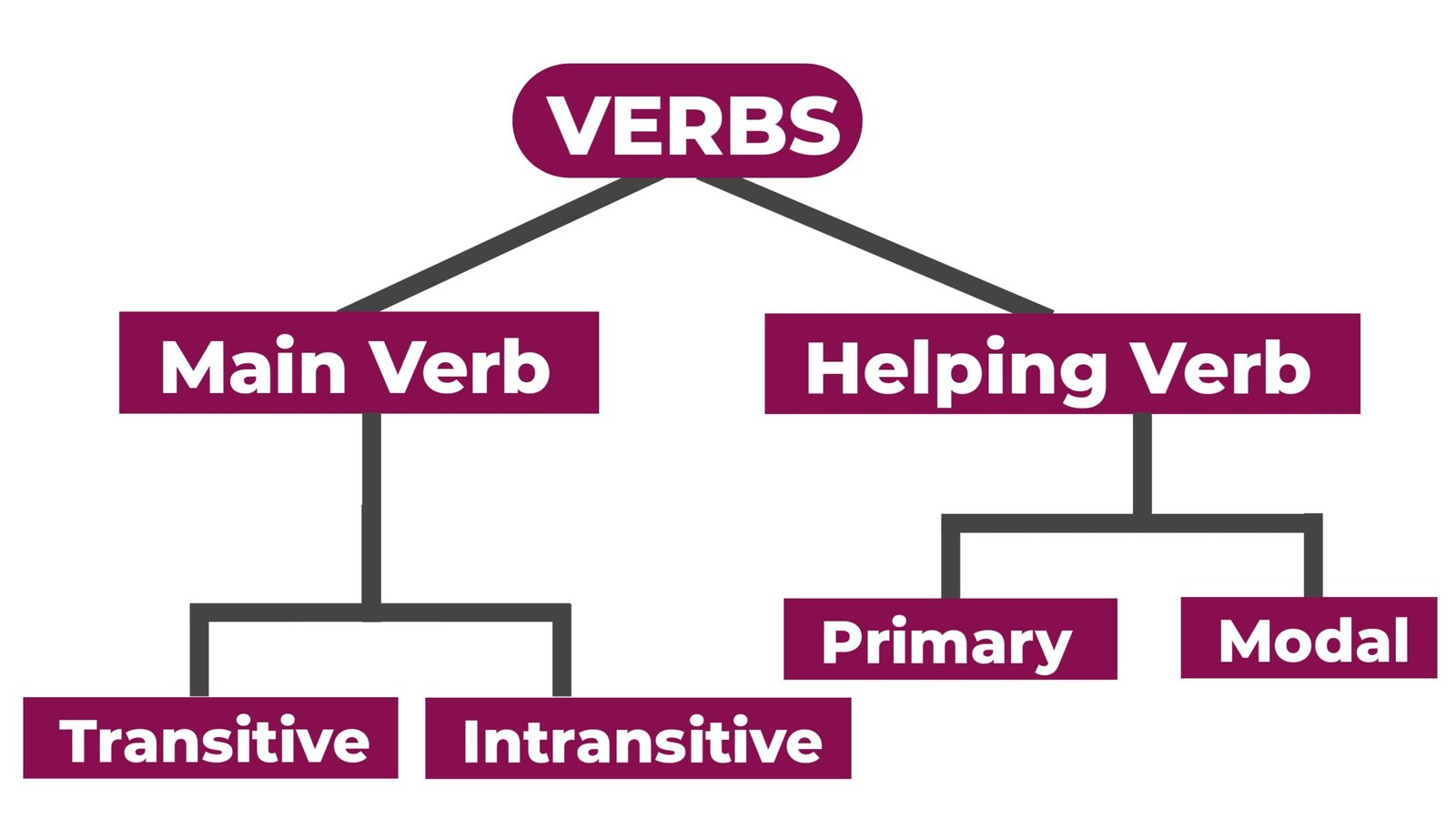Verb (क्रिया) – अंग्रेजी में Verb का मतलब होता है कि हम जो कुछ भी काम कर रहे है या जो भी काम हो रहा है। हम सुबह से लेकर शाम तक जो भी काम करते है चाहे वो पढ़ना हो, लिखना हो, किसी से बात करना हो, हँसना हो, रोना हो, आना हो, जाना हो इत्यादि सभी क्रिया अर्थात् Verb के बेहतरीन उदाहरण है, बिना Verb के कोई भी वाक्य अधूरा है।
In English, the verb means whatever the work we are doing, or whatever the work is going on. Whatever the work we do from morning to evening, whether it is reading, writing, talking to someone, to laugh, to cry, to come, to go, etc. All these are great examples of verb, without verb the sentence is incomplete.
मान लीजिए कि आप अंग्रेजी सीख रहे है अर्थात् आप Subject है और कोई action कर रहे है जिसका नाम है सीखना ।
EX –
विवेक अंग्रेजी सीख रहा है । (Learn – सीखना)
Vivek is learning English.
वह सब्ज़ी बेचता है । (Sell – बेचना)
He sells vegetables.
अंग्रेजी में Verb की शुरुआत Main Verb तथा Auxiliary Verb से होता है। जिसे आप अपनी भाषा में Helping Verb के नाम से जानते होंगे।

इसके बाद Main Verb के भी दो प्रकार है।
1) Transitive Verb (सकर्मक क्रिया)
2) Intransitive Verb (अकर्मक क्रिया)
इसी तरह Helping Verb को भी दो भागों में विभाजित किया जा सकता है।
1) Primary Verb
2) Modal Verbs
सबसे पहले हम शुरू करेंगे Main Verb और Helping Verb से। हमने वाक्य बनाने का एक Structure सीखा है जिसमें अंग्रेजी का कोई भी Sentence हो वो सारी चीजें उस वाक्य में ज़रूर आती है जितनी इस Structure में है आइए देखें।
We will first start off with Main Verb and Helping Verb, We have learnt a structure to form a sentence, in which any Sentence of English contains everything that comes in this structure, let’s see.
Subject + H.V. + M.V. + Object.
आइए कुछ वाक्य बनाए ताकि आपको ये समझ आ जाए।
मैं अंग्रेजी सीख रहा हूँ।
I am learning English.
इस वाक्य में I (आई) एक Subject है यहाँ इस वाक्य को पूरा करने के लिए Helping Verb के तौर पर am का प्रयोग किया गया है क्योंकि ये वाक्य Present Continuous Tense में है और Subject है I (आई) और हम जानते है कि Present Continuous Tense में वाक्य बनाते समय अगर I (आई) आता है तो Helping Verb के तौर पर am का प्रयोग किया जाता है इसके बाद आती है Main Verb जहां Present Continuous Tense में (V1+ing) का प्रयोग किया जाता है। Verb का पहला रूप था Learn इसके साथ लगेगा ing तो बनेगा Learning और Object मतलब जिस पर काम हो रहा है, यहाँ English सीखी जा रही है इसलिए काम English पर हो रहा है तो वह Object है।
In this sentence (I) is a Subject. Here am is used as a Helping Verb to complete this sentence because this sentence is in Present Continuous Tense and Subject is (I) and we know that If (I) comes in Present Continuous Tense then am is used as a Helping Verb, it is followed by a Main Verb where (V1+ing) is used in Present Continuous Tense, The first form of Verb was Learn if ing added to it then it will become Learning, and Object means on which work is being done here, English is being learned, so if the work is being done on English then it is an Object.
सपेरा साँप को नचा रहा है।
The snake charmer is making the snake dance.
उसने ज़ोर से घंटी बजाई।
He rang the bell loudly.
तो ये तो बात हुई Main Verb और Helping Verb की अब समझते है इनके प्रकारों को सबसे पहले देखते है Main Verb के प्रकार।
So it is all about Main Verb and Helping Verb, now let’s understand it’s types let us first see the types of Main Verb.
1) Transitive Verb (सकर्मक क्रिया)
2) Intransitive Verb (अकर्मक क्रिया)
1) Transitive Verb (सकर्मक क्रिया) – ऐसी Verbs जो अपने साथ Object का प्रयोग करती है ताकि जो कहा गया है वो स्पष्ट हो सके, उसे Transitive Verb (सकर्मक क्रिया) कहते है। या इसे ऐसे भी कहा जा सकता है कि जब यदि Verb से “क्या”, “किसे” पूछने पर उत्तर मिले उसे Transitive Verb कहते है।
A Verb which uses an Object with it to complete its sense is called a Transitive Verb.
Note : अगर आपने अभी तक कौन / किसने या क्या / किसे वाला तरीक़ा नही सीखा है तो यहाँ क्लिक करें।
मैने बॉल फेंकता हूँ।
I throw the ball.
उसने मुझे बुलाया।
He called me.
मैंने फ़ुटबॉल मारी।
I kicked the football.
मैने उसे डाँटा।
I scolded him.
यहाँ throw, called, kicked, scolded Transitive Verb की तरह प्रयुक्त हुए है जिसमें action कर्ता (Subject) तक सीमित न रहकर Objects (me, football, him) तक जा रहा है।
Here throw, called, kicked, scolded are used as a Transitive Verb in which the action is not limited to the Subject but also referred to the Objects (me, football, him).
2) Intransitive Verb (अकर्मक क्रिया) – ऐसी Verbs जो कर्ता (Subject) सीमित रहती है Object तक नही जाती Intransitive Verb कहलाती है। या इसे ऐसे भी कहा जा सकता है कि वह Verb जो अपना अर्थ स्पष्ट करने के लिए Object नही लेता उसे Intransitive Verb कहते है।
A verb which is limited to the subject is called a Transitive Verb.
Or
A verb which doesn’t require an Object to complete its sense is called an Intransitive verb.
पतंग उड़ती है।
Kite flies.
वह आता है।
He comes.
हम जीने के लिए खाते है।
We eat to live.
बारिश रुक गयी।
The rain stopped.
यहाँ flies, comes, live, stopped Intransitive Verb की तरह प्रयुक्त हुए है जिसमें action कर्ता (Subject) तक सीमित है।
here flies, comes, live, stopped are used as an Intransitive Verb in which the action is limited to the Subject.
अब बात करते है Helping Verb के types की।
1) Primary Auxiliary Verbs
2) Modal Auxiliary Verbs
1) Primary Auxiliary Verb – Primary Auxiliary Verb ऐसी Verb है जिसमें “to be”, “to do”, “to have” सहायक क्रिया (helping verb) तथा मुख्य क्रिया (Main Verb) दोनो की तरह कार्य करे उसे Primary Auxiliary Verb कहा जाता है। इसे तीन भागों में विभाजित किया जा सकता है।
A primary auxiliary verb is a verb in which “to be”, “to do”, “to have” function both as a main verb and an auxiliary verb. It can be divided into three types.
“to be forms Examples”
बिल गेट्स सबसे अमीर इंसान है।
Bill Gates is a very rich person.
तुम्हारा फ़ोन आ रहा है।
Your phone is ringing.
वह कब आने वाला है।
When is he going to come.
वह अपना घर किराए से देने वाला है।
He is going to let his house.
तुम बहुत दयालु हो।
You are very kind.
लोग बहुत कुटिल होते है।
People are so cunning/ shrewd.
मैं उसकी तरह परिश्रमी नही हूँ।
I am not a laborious like him.
कोई तुम्हारा इंतजार कर रहा है।
Someone is waiting for you.
ये तुम्हारे लिए है।
This is for you.
“to do forms Examples”
(do/does/did) को समझाने से पहले मेरी आपसे एक गुज़ारिश है कि आप पहले इस वीडियो को देख ले ताकि आपको “to do forms” समझने में दिक़्क़त ना हो।
Before explaining “to do forms” (do / does / did), I request you to watch this video first so that you can easily understand “to do forms”.
मैं उससे मिला तो था।
I did meet him.
वह पढ़ता तो है।
He does read.
तुम कमाते तो हो।
You do earn.
मैने उसे फ़ोन लगाया तो था।
I did call him.
उसने खाना टाइम पर खाया तो सही।
He does eat food on time.
वह कल आया तो था।
He did come yesterday.
मुझे ऑमलेट पसंद तो है।
I do like omelette.
तुमने T.V. देखी तो सही।
You did watch T.V.
उसके पास खिलौने है तो सही।
He does have toys.
और आना। (विदा देते समय)
Do come again.
उसकी मदद करना।
Do help him.
“to have forms Examples”
मेरे पास कार है।
I have car./ I have got a car.
मेरे बहुत मित्र है।
I have many friends.
क्या तुम्हारा एक बेटा है?
Do you have (got) a son?
तुम्हारे पास मेरे लिए क्या है?
What do you have for me?
मेरे पास घर है, गाड़ी है, बंगला है तुम्हारे पास क्या है?
I have a house, a car and bungalow what do you have?
क्या तुमने मेरा मोबाइल कहीं देखा है?
Have you seen my mobile anywhere?
क्या तुम कभी न्यूजर्सी गये हो?
Have you ever been to New Jersey?
जीने का हक़ सबको है।
Everyone has a right to live.
मुझे अंदाज़ा नही है।
I have no idea.
तुम्हारे पास मेरे ख़िलाफ़ क्या सबूत है।
What proofs do you have against me.



